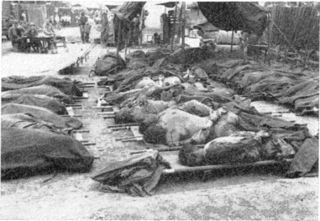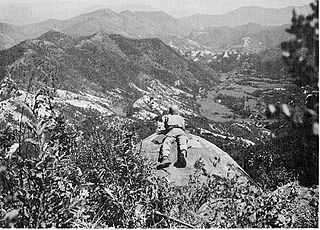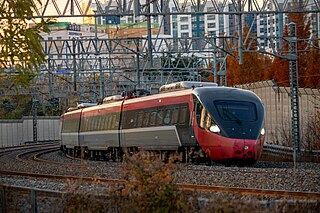
Daegu, formerly spelled Taegu and officially Daegu Metropolitan City (대구광역시), is a city in southeastern South Korea.

The Gyeongbu line (Gyeongbuseon) is a railway line in South Korea and is considered to be the most important and one of the oldest in the country. It was constructed in 1905, connecting Seoul with Busan via Suwon, Daejeon, and Daegu. It is by far the most heavily travelled rail line in South Korea.

Cheongdo County (Cheongdo-gun) is a county in North Gyeongsang Province, South Korea. It is connected to the national transportation grid by the Gyeongbu Line railroad and the Daegu-Busan Expressway. The seat of government is located in the center of the county, in Hwayang-eup.

The Nakdong River or Nakdonggang is the longest river in South Korea, which passes through the major cities of Daegu and Busan. It takes its name from its role as the eastern border of the Gaya confederacy during Korea's Three Kingdoms Era.

The Battle of the Pusan Perimeter, known in Korean as the Battle of the Naktong River Defense Line, was a large-scale battle between United Nations Command (UN) and North Korean forces lasting from August 4 to September 18, 1950. It was one of the first major engagements of the Korean War. An army of 140,000 UN troops, having been pushed south to the brink of defeat, were rallied to make a final stand against the invading Korean People's Army (KPA), 98,000 men strong.
The Jungang Expressway (Korean: 중앙고속도로) is an expressway in South Korea. Its name literally means "Central Expressway," and for much of its length it runs through mountainous terrain near the country's east-west center line, including the national parks of Chiaksan and Sobaeksan. It covers a total distance of roughly 388.1 kilometers.

Lieutenant General Hobart Raymond Gay, nicknamed "Hap", was a United States Army officer who served in numerous conflicts, including World War II, where he worked closely alongside General George S. Patton, and later in the Korean War, where he commanded the 1st Cavalry Division.

Imjingak, and sometimes in English called the Imjingak resort, is a park located on the banks of the Imjin River along the tracks of the former Gyeongui Train Line outside the city of Paju, South Korea. The park has many statues and monuments regarding the Korean War. There is also a restaurant, an observation deck, a pool in the shape of the Korean peninsula, and even a small amusement park.

Rail transport in South Korea is a part of the transport network in South Korea and an important mode of the conveyance of people and goods, though railways play a secondary role compared to the road network. The network consists of 4,285 km (2,663 mi) of standard-gauge lines connecting all major cities with the exception of Jeju City on Jeju Island, which does not have railways; of the network, 2,790 km (1,730 mi) are double-tracked and 3,187 km (1,980 mi) are electrified. In 2018, rails carried 11.5 percent of all traffic in South Korea – 134.8 million passengers and 30.9 million tonnes of freight – with roads carrying 88.3 percent.

Camp Carroll Army Base is located on the southeast portion of the peninsula of South Korea, in the village of Waegwan, approximately 20 km from the city of Daegu. Camp Carroll is bound by urban areas on the northwest, west, and southwest. Hilly forested areas bound the base on the north and east. Agricultural fields border the base on the northeast and to the south. The Nakdong River flows nearby, southwest of the base. Camp Carroll has been a supply staging ground for U.S. military operations on the peninsula and in the Far East since the late 1950s. Often referred to as "The Crown Jewel of Area 4", it is named after Sergeant First Class Charles F. Carroll, a posthumous recipient of the Distinguished Service Cross for his acts of heroism during the Korean War.

The Gyeongbu high-speed railway, also known as Gyeongbu HSR, is South Korea's first high-speed rail line from Seoul to Busan. KTX high-speed trains operate three sections of the line: on 1 April 2004, the first between a junction near Geumcheon-gu Office station, Seoul and a junction at Daejeonjochajang station north of Daejeon, and a second between a junction at Okcheon station, southeast of Daejeon, and a junction near Jicheon station, north of Daegu entered service; then on 1 November 2010, the third section, between a junction west of Daegu and Busan became operational. The missing gaps across the urban areas of Daejeon and Daegu were in construction for an expected opening in 2014, separate tracks into Seoul Station were also planned. The temporary ends of the three sections were connected to the parallel conventional Gyeongbu Line by tracks that will serve as interconnector branches upon the completion of the entire line. On 1 August 2015, construction on urban areas of Daejeon and Daegu were completed; all the sections of HSR line were connected.

The KTX-I, also known as the TGV-K or Korail Class 100000, is a South Korean high speed train class based on the French TGV Réseau. The 20-car formation of the trainsets without a restaurant car is optimized for high capacity. The 46 trainsets were built partly in France and partly in South Korea in the framework of a technology transfer agreement, which was the basis for further domestic high-speed train development in South Korea.
The Autumn Uprising of 1946, also called the 10.1 Daegu Uprising of 1946 was a peasant uprising in South Korea against the policies of the United States Army Military Government in Korea headed by General John R. Hodge and in favor of restoration of power to the people's committees that made up the People's Republic of Korea. The uprising is also sometimes called the Daegu Riot or Daegu Resistance Movement. The Truth and Reconciliation Commission of South Korea uses a neutral name, the Daegu October Incident.

The Battle of Taegu was an engagement between United Nations Command (UN) and North Korean forces early in the Korean War, with fighting continuing from August 5–20, 1950 around the city of Taegu, South Korea. It was a part of the Battle of Pusan Perimeter, and was one of several large engagements fought simultaneously. The battle ended in a victory for the UN after their forces were able to drive off an offensive by Korean People's Army (KPA) divisions attempting to cross the Naktong River and assault the city.

The Hill 303 massacre was a war crime that took place during the opening days of the Korean War on August 17, 1950, on a hill above Waegwan, Republic of Korea. Forty-one United States Army (US) prisoners of war were murdered by troops of the North Korean People's Army (KPA) during one of the engagements of the Battle of Pusan Perimeter.

The Battle of Tabu-dong was an engagement between United Nations Command (UN) and North Korean forces early in the Korean War from September 1 to September 15, 1950, in the vicinity of Tabu-dong, Chilgok County, north of Taegu in South Korea. It was a part of the Battle of Pusan Perimeter, and was one of several large engagements fought simultaneously. The battle ended in a victory for the UN after large numbers of United States Army (US) and Republic of Korea Army (ROK) troops repelled a strong Korean People's Army (KPA) attack.

Saint Maurus and Saint Placidus Abbey, Waegwan, Chilgok, North Gyeongsang, South Korea is a Benedictine monastery of the Congregation of Missionary Benedictines of Saint Ottilien. Established in 1952 by Korean monks who had survived the dissolution of the Territorial Abbey of Tokwon and Holy Cross Abbey in Yanji, the monastery is currently home to 131 monks. Fr Blasio Park is the current abbot.

The Hangang Railway Bridge (Korean: 한강철교) crosses the Han River in Seoul, South Korea and connects Noryangjin Station and Yongsan Station.

The Intercity Train eXpress-Saemaeul abbreviated as ITX-Saemaeul (Korean: ITX-새마을) is a class of train operated by Korail, the national railroad of South Korea, it was introduced on May 12, 2014, to replace the Saemaeul-ho. The new ITX-Saemaeul trains have a faster average speed of 150 kilometers per hour. The name was taken from the Saemaul Undong after a public competition to determine the new train's name.

The Pusan Perimeter offensive was a large-scale offensive by United Nations Command (UN) forces against North Korean forces commencing on 16 September 1950.




















